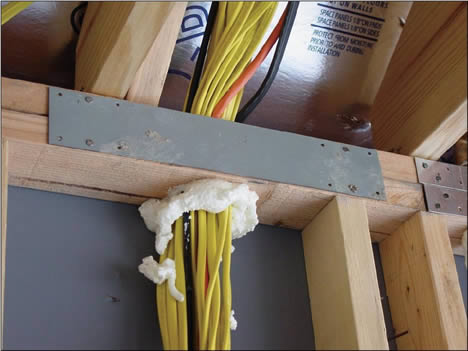March 2005
New Research Leads to Electrical Code Change
Almost every home has electrical cables bundled together in various locations, and those bundled wires typically run through holes in the wood framing. Do such bundles get hot enough to create a fire hazard? The answer is "not likely, but it could happen," especially when a combination of undersized wiring and high current loads are present, says Bill Black, vice president of wire & cable for the Copper Development Association.

Recent research has shown that bundled cables passing through holes in building materials can reach dangerously high temperatures, particularly when outdoor and attic temperatures are also elevated.
The Trouble with Bundles
Overheating is compounded when some of the wires are not only bundled tightly together but are also carrying heavy electric-current loads. Black says, in tests conducted recently, the worst scenario occurred when loaded, bundled wires passed vertically through a hole in building materials such as wood wall framing. According to most construction codes, such holes must be "fire-stopped" with insulating material. Although this is intended to control the spread of a house fire, it has the unintentional effect of preventing heat generated in the hole from escaping. Under these conditions, wire temperatures can approach, and sometimes exceed, the maximum rated temperature of wire-insulation materials (typically 194 degrees Fahrenheit).
New Code Requirements
Faced with these research results, the CDA, which sponsored the research, proposed a change to the National Electrical Code. Though the new Code does not prohibit wire bundling, it does require that measures be taken, known as "derating," to prevent excessive heat buildup.
Bundling can be especially hazardous above the electrical panel, where many wires converge and the loads are concentrated. It's a good idea to visually check for bundles of wires throughout your home, Black recommends.
If you have doubts about the safety of the wiring in your home, you should call a qualified electrician. If you and your electrician determine that unsafe or hazardous conditions exist, you need to take immediate corrective action. You can also visit CDA's Building Wiring section for more information about residential electrical wiring. ![]()
